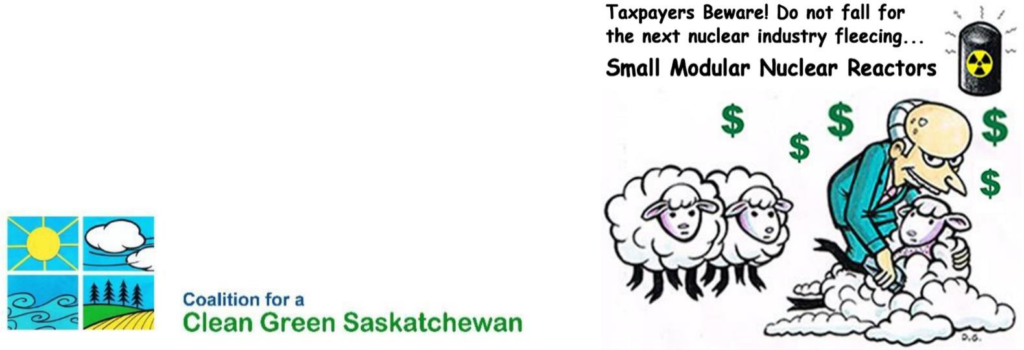SMRs = nuclear reactors generating between 10 and 300 megawatts of electricity
The much hyped “nuclear renaissance”, based on a proposed new generation of reactor designs, seems over before it began, certainly in the Western world. That’s because of the rapid growth of cheaper high-tech renewable energy, energy storage technologies, greatly improved energy efficiency, plentiful lowcost natural gas, and staggeringly large costs for new nuclear plants large or small. In addition there are deep concerns about nuclear’s unique hazards * extremely long-lived environmental contamination and radioactive waste lasting into eternity.
*See detailed info at link below – The hazards of ionizing radiation on human health.
Yet the Government of Canada, through the Ministry of Natural Resources, is spending huge sums of your tax dollars promoting a new generation of small modular nuclear reactors (SMRs) – none of them ever tested.

Canada has already failed in the “small reactor” market with fiascos like the Maple Reactors and the SLOWPOKE district heating reactor. Many analysts and experts say that there is no demand for the unnecessary and speculative new SMR designs. They would perpetuate, and even exacerbate existing problems with nuclear power. Nor could they realistically address climate change (links below give detailed reasons).
Unless Canadians speak out, a lot of money will be wasted, a lot of nuclear contamination created, and a lot of damage done, even if SMRs turn out to be just another spectacular technological flop.
- As far back as May, 2012 Forbes magazine noted that there is no demonstrated market for
SMRs, partly because they simply cannot compete with low emission combined-cycle gas-fired power plants at one quarter of the cost. Between 2012 and now the cost disparity has grown much larger. - SMRs, by their small nature, would be inherently less efficient and more expensive than large reactors per unit of power produced because they lose the economies of scale (wildly speculative economies of planned modular factory design notwithstanding). Ironically, the first power reactor designs in the1960s were similarly small but grew, over the decades, to take advantage of the economies of scale. From a financial and efficiency perspective, then, the return to small is a retrograde move.
- Safety parameters for these devices are unknown. Regulations for exclusion zones, amount of staffing, emergency evacuation zones, legal liability insurance, terrorist and criminal security standards, arms proliferation risks, and earthquake, fire and flood regulations would all have to be rewritten to suit the nature of SMRs. This would slow down commercial licensing prospects, perhaps for decades, and thus discourage investors.
- Unlike conventional reactor models, many SMR designs situate the reactor core underground, aggravating the problems of groundwater contamination, flooding and earthquake vulnerability. Accessibility would also be limited in case of emergency and subsequent fuel removal.
Prominent American nuclear physicist Edwin Lyman, Senior Scientist in the Global Security Program of The Union of Concerned Scientists, has dismissed this technology, stating that SMRs are all in the “stage of fantasy”. He characterized the public discussion of them as “irrational exuberance”.
In April 2018, William Von Hoene, Senior VP of Exelon, the US’s largest nuclear operator, told the US Energy Association’s annual meeting in Washington: “I don’t think we are building any more nuclear plants in the United States, I don’t think it’s ever going to happen…Right now the costs on the SMR’s, in part because of the size and in part because of the security that is associated with any nuclear plant, are prohibitive.”
In an online MIT journal article, “Small Modular Nuclear Reactors and the Future of Nuclear Power” Mark Cooper, PhD, of Vermont Law School / Yale University, concluded that SMRs are all but dead – demonstrated by the scale-backs of major players Babcock & Wilcox, Westinghouse & Transatomic Power, the technology’s poor economics, and the general lack of interest from utilities and lending institutions.
In spite of the proponents’ promotional hype, the signs seem clear – small modular reactors are a non-starter in the energy marketplace. Canadian taxpayers’ money should not be squandered on this risky, retro, uncompetitive, expensive, and completely unnecessary venture. Canada’s policies must not be for the convenience of the dying and desperate nuclear industry but for the benefit of people. We should commit our resources to a broad range of more modern energy strategies and options – options which have proven to be much more cost-competitive, environmentally sound, and sustainable for the long term.
D. S. Geary
For detailed critiques of SMRs see:
> Small modular reactors and the future of nuclear power in the United States. Mark Cooper
> WISE: SMRs Future or Folly
> SMR’s: A Case of Wishful Thinking, by Gordon Edwards 2020
> Are SMRs the answer? (No) Climate Change News
> SMRs Have Little Appeal – Climate News Network, July 2018
> Small modular reactors: an introduction and an obituary
> Eyes Wide Shut – SMRs by M.V. Ramana Sept 2020
> The hazards of ionizing radiation on human health – CleanGreenSask.ca 2020

